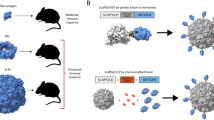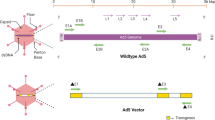Abstract
In spite of ongoing annual vaccination programs, the seasonal influenza epidemics remain a major cause of high morbidity and mortality. The currently used “inactivated” vaccines provide very short-term and highly specific humoral immunity due to the frequent antigenic variations in the influenza virion. These intra-muscularly administered vaccines also fail to induce protective mucosal immunity at the portal of viral entry and destruction of the virally infected cells by induction of cytotoxic T lymphocytes. Therefore, it is necessary to develop immunologically superior vaccines. This article highlights some of the recent developments in investigational influenza vaccines. The most notable recent developments of interest include the use of immunopotentiators, development of DNA vaccines, use of reverse genetics, and the feasibility of mammalian cell-based production processes. Presently, due to their safety and efficacy, the cold-adapted “live attenuated” vaccines are seen as viable alternatives to the “inactivated vaccines”. The DNA vaccines are gaining importance due to the induction of broad-spectrum immunity. In addition, recent advances in recombinant technologies have shown the possibility of constructing pre-made libraries of vaccine strains, so that adequately preparations can be made for epidemics and pandemics.



Similar content being viewed by others
References
Babai I, Barenholz Y, Zakay-Rones Z, Greenbaum E, Samira S, Hayon I, Rochman M, Kedar E (2001) A novel liposomal influenza vaccine (INFLUSOME-VAC) containing hemagglutinin-neuraminidase and IL-2 or GM-CSF induces protective anti-neuraminidase antibodies cross-reacting with a wide spectrum of influenza A viral strains. Vaccine 20:505–515
Belshe RB (2004) Current status of live attenuated influenza virus vaccine in the US. Virus Res 103:177–185
Bowersock TL, Martin S (1999) Vaccine delivery to animals. Adv Drug Deliv Rev 38:167–194
Caton A, Brownlee G, Yewdell J, Gerhard W (1982) The antigenic structure of the influenza virus A/PR/8/34 hemagglutinin (H1 subtype). Cell 31:417–427
Clements ML, Snyder MH, Buckler-White AJ, Tierney EL, London WT, Murphy BR (1986) Evaluation of avian-human reassortant influenza A/Washington/897/80 x A/Pintail/119/79 virus in monkeys and adult volunteers. J Clin Microbiol 24:47–51
Donnelly JJ, Friedman A, Ulmer J, Liu MA (1997) Further protection against antigenic drift of influenza virus in a ferret model by DNA vaccination. Vaccine 15:865–868
Gerdil C (2003) The annual production cycle for influenza vaccine. Vaccine 21:1776–1779
Hannoun C, Megas F, Piercy J (2004) Immunogenicity and protective efficacy of influenza vaccination. Virus Res 103:133–138
Herzog C, Metcalfe IC, Schaad UB (2002) Virosome influenza vaccine in children. Vaccine 20:B24–B28
Hilleman MR (2002) Realities and enigmas of human viral influenza: pathogenesis, epidemiology and control. Vaccine 20:3068–3087
Hoffmann E, Neumann G, Hobom G, Webster RG, Kawaoka Y (2000) “Ambisense” approach for the generation of influenza A viruses: vRNA and mRNA synthesis from one template. Virology 267:310–317
Hoffmann E, Krauss S, Perez D, Webby R, Webster RG (2002) Eight-plasmid system for rapid generation of influenza virus vaccines. Vaccine 20:3165–3170
Horimoto T, Horimoto KI, Hatta M, Kawaoka Y (2004) Influenza A viruses possessing type B hemagglutinin and neuraminidase: potential as vaccine components. Microbes Infect 6:579–583
Jin H, Lu B, Zhou H, Ma C, Zhao J, Yang CF, Kemble G, Greenberg H (2003) Multiple amino acid residues confer temperature sensitivity to human influenza virus vaccine strains (FluMist) derived from cold-adapted A/Ann Arbor/6/60. Virology 306:18–24
Joseph A, Louria-Hayon I, Plis-Finarov A, Zeira E, Zakay-Rones Z, Raz E, Hayashi T, Takabayashi K, Barenholz Y, Kedar E (2002) Liposomal immunostimulatory DNA sequence (ISS-ODN): an effective parenteral and mucosal adjuvant for influenza and hepatitis B vaccines. Vaccine 20:3342–3354
Justewicz DM, Morin MJ, Robinson HL, Webster RG (1995) Antibody-forming cell response to virus challenge in mice immunized with DNA encoding the influenza virus hemagglutinin. J Virol 69:7712–7717
Kemble G, Greenberg H (2003) Novel generations of influenza vaccines. Vaccine 21:1789–1795
Kendal AP (1997) Cold-adapted live attenuated influenza vaccines developed in Russia: can they contribute to meeting the needs for influenza control in other countries? Eur J Epidemiol 13:591–609
Kistner O, Barrett PN, Mundt W, Reiter M, Schober-Bendixen S, Dorner F (1998) Development of a novel mammalian cell (Vero)-derived influenza vaccine. Vaccine 16:960–968
Li SQ, Liu CG, Klimov A, Subbarao K, Perdue ML, Mo D, Ji Y, Woods L, Hietala S, Bryant M (1999) Recombinant influenza A virus vaccines for the pathogenic human A Hong Kong 97 (H5N1) viruses. J Infect Dis 179:1132–1138
Ljungberg K, Wahren B, Almqvist J, Hinkula J, Linde A, Winberg G (2000) Effective construction of DNA vaccines against variable influenza genes by homologous recombination. Virology 268:244–250
Maassab HF, DeBorde DC (1985) Development and characterization of cold-adapted viruses for use as live vaccines. Vaccine 3:335–369
Morein B, Sundquist B, Hoglund S, Dalsgaard K, Osterhaus A (1984) ISCOM, a novel structure for antigen presentation of membrane proteins of enveloped viruses. Nature 308:457–460
Murphy BR, Chalhub EG, Nusinoff SR, Chanock RM (1972) Temperature-sensitive mutants of influenza virus. II Attenuation of ts recombinants for man. J Infect Dis 126:170–178
Nagai T, Suzuki Y, Kiyohara H, Susa E, Kato T, Nagamine T, Hagiwara Y, T SI, Yabe T, Aizawa C, Yamada H (2001) Onjisaponins, from the root of Polygala tenuifolia Willdenow, as effective adjuvants for nasal influenza and diphtheria-pertussis-tetanus vaccines. Vaccine 19:4824–4834
Neirynck S, Deroo T, Saelens X, Vanlandschoot P, Min Jou W, Fiers W (1999) A universal influenza A vaccine based on the extra cellular domain of the M2 protein. Nat Med 5:1157–1163
Neumann G, Zobel A, Hobom G (1994) RNA polymerase I-mediated expression of influenza viral RNA molecules. Virology 202:447–449
Neumann G, Watanabe T, Ito H, Watanabe S, Goto H, Gao P, Hughes M, Perez DR, Donis R, Hoffmann E, Hobom G, Kawaoka Y (1999) Generation of influenza A viruses entirely from cloned cDNAs. Proc Natl Acad Sci USA 96:9345–9350
Nicholson KG, Wood JM, Zambon M (2003) Influenza. Lancet 362:1733–1745
Okuda K, Ihata A, Watabe S, Okada E, Yamakawa T, Hamasima K, Yang J, Ishii N, Nakazawa M, Okuda K, Ohnari K, Nakajima K, Xin KQ (2001) Protective immunity against influenza A virus induced by immunization with DNA plasmid containing influenza M gene. Vaccine 19:3681–3691
Palese P, Zavala F, Muster T, Nussenzweig RS, Garcia-Sastre A (1997) Development of novel influenza virus vaccines and vectors. J Infect Dis 176:S45–S49
Pau MG, Ophorst C, Koldijk MH, Schouten G, Mehtali M, Uytdehaag F (2001) The human cell line PER.C6 provides a new manufacturing system for the production of influenza vaccines. Vaccine 19:2716–2721
Pfleiderer M, Löwer J, Kurth R (2002) Cold-attenuated live influenza vaccines, a risk-benefit assessment. Vaccine 20:886–894
Plante M, Jones T, Allard F, Torossian K, Gauthier J, St-Félix N, White GL, Lowell GH, Burt DS (2001) Nasal immunization with subunit proteosome influenza vaccines induces serum HAI, mucosal IgA, and protection against influenza challenge. Vaccine 20:218–225
Podda A (2001) The adjuvanted influenza vaccines with novel adjuvants: experience with the MF59-adjuvanted vaccine. Vaccine 19:2673–2680
Ramanathan RK, Potter DM, Belani CP, Jacobs SA, Gravenstein S, Lim F, Kim H, Savona S, Evans T, Buchbarker D, Simon MB, Depee JK, Trump DL (2002) Randomized trial of influenza vaccine with granulocyte-macrophage colony-stimulating factor or placebo in cancer patients. J Clin Oncol 20:4313–4318
Rimmelzwaan GF, Osterhaus ADME (2001) Influenza vaccines: new developments. Curr Opin Pharmacol 1:491–496
Rimmelzwaan GF, Baars M, van Amerongen G, van Beek R, Osterhaus ADME (2001) A single dose of an ISCOM influenza vaccine induces long-lasting protective immunity against homologous challenge infection but fails to protect Cynomolgus macaques against distant drift variants of influenza A (H3N2) viruses. Vaccine 20:158–163
Robinson HL, Hunt LA, Webster RG (1993) Protection against a lethal influenza virus challenge by immunization with a hemagglutinin-expressing plasmid DNA. Vaccine 11:957–960
Seo SH, Goloubeva O, Webby R, Webster RG (2001) Characterization of a porcine lung epithelial cell line suitable for influenza virus studies. J Virol 75:9517–9525
Slepushkin VA, Katz JM, Black RA, Gamble WC, Roata PA, Cox NJ (1995) Protection of mice against influenza A virus challenge by vaccination with baculovirus-expressed M2 protein. Vaccine 13:1399–1402
Tree JA, Richardson C, Fooks AR, Clegg JC, Looby D (2001) Comparison of large-scale mammalian cell culture systems with egg culture for the production of influenza virus a vaccine strains. Vaccine 19:3444–3450
Ulmer JB (2002) Influenza DNA vaccines. Vaccine 20:S74–S76
Wareing MD, Tannock GA (2001) Live attenuated vaccines against influenza: an historical review. Vaccine 19:3320–3330
Watanabe T, Watanabe S, Kida H, Kawaoka Y (2002a) Influenza A virus with defective M2 ion channel activity as a live vaccine. Virology 299:266–270
Watanabe T, Watanabe S, Neumann G, Kida H, Kawaoka Y (2002b) Immunogenicity and protective efficacy of replication-incompetent influenza virus-like particles. J Virol 76:767–773
Wolff JA, Malone RW, Williams P, Chong W, Ascadi G, Jani A, Felgner PL (1990) Direct gene transfer into mouse skeleton muscle in vivo. Science 247:1465–1468
Youil R, Su Q, Toner TJ, Szymkowiak C, Kwan WS, Rubin B, Petrukhin L, Kiseleva I, Shaw AR, DiStefano D (2004) Comparative study of influenza virus replication in Vero and MDCK cell lines. J Virol Methods 120:23–31
Author information
Authors and Affiliations
Corresponding author
Rights and permissions
About this article
Cite this article
Bardiya, N., Bae, J.H. Influenza vaccines: recent advances in production technologies. Appl Microbiol Biotechnol 67, 299–305 (2005). https://doi.org/10.1007/s00253-004-1874-1
Received:
Revised:
Accepted:
Published:
Issue Date:
DOI: https://doi.org/10.1007/s00253-004-1874-1




